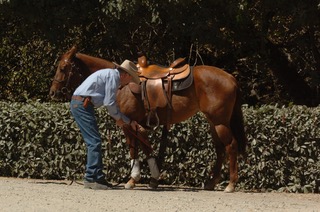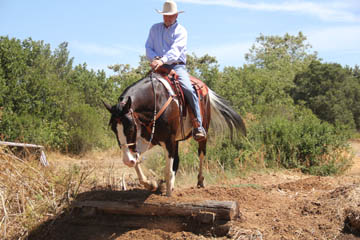 When the big day comes to saddle up for the first time, it is usually not a really big deal when you have put the time in on ground work and you have a solid foundation. When you have worked with your horse to desensitize her to the saddle blanket, the next step is to get her accustomed to the cinch. A horse’s belly is a very sensitive area. Out in the wild, the legs and belly are really vulnerable areas. It is a tender zone and horses are naturally nervous about contact around their stomachs. Horses have a natural inclination to be “cinchy” or resistant to being cinched, so it is our job to help them feel comfortable and confident when cinched up for riding.
When the big day comes to saddle up for the first time, it is usually not a really big deal when you have put the time in on ground work and you have a solid foundation. When you have worked with your horse to desensitize her to the saddle blanket, the next step is to get her accustomed to the cinch. A horse’s belly is a very sensitive area. Out in the wild, the legs and belly are really vulnerable areas. It is a tender zone and horses are naturally nervous about contact around their stomachs. Horses have a natural inclination to be “cinchy” or resistant to being cinched, so it is our job to help them feel comfortable and confident when cinched up for riding.
Signs that your horse is uncomfortable with the cinch include pinning of the ears, eyes getting bigger, the head going up, showing teeth and turning the head toward you to bite. The rope exercise will help desensitize your horse to the feeling of pressure caused by a cinch around the belly. The exercise allows you to prepare your horse for cinching without the added weight and pressure of a saddle. This exercised may also be sued for horse that are being ridden but are cinchy when being saddled.
For this exercise you need a 25 to 30 foot line with a snap on the end to create a rope cinch. Attach a 12-foot line to the horses halter. With one hand, hold your horse and stand across and slightly in front of your horse’s shoulder. With your other hand, place the snap end of the 30-foot line over your horse’s back. Use a cane to reach the snap and bring it under the belly. Thread the other end of the rope through the snap to make a cinch but don’t pull the rope tight. To begin, do a quick, rhythmic pull and release until the horse starts to relax. Don’t pull, then wait for the horse to relax, and then release but just pull, release, pull, release, quickly and with a minimum of pressure. Even though the horse may be cranky, just keep doing the exercise. After a while your horse will be less intimidated by the exercise and will start to relax. When the horse is relaxed, you can fine-tune the type of reaction by holding the rope firmly until you see a better response. As the horse gets comfortable feeling the rope tighten and loosen, you can increase the rope’s tightness, making the pressure a pound or so of contact weight. Tighten… relax… release. Continue increasing the contact and pressure until you are at the level of tightness with the rope that you would be with your cinch. The exercise may take three, five or more sessions until you see your horse staying relaxed when you tighten the rope.
It is very important to do cinch exercises. Of all the horses I have started or restarted, at least 50% have a buck in them when they are first cinched and sent off in the round pen or on a line. I recently worked on the rope cinching exercise with one horse and I put the saddle on and off until the horse was comfortable. Then I put the saddle on and cinched it as quickly and gently as I could. You want to do this quickly to make sure that if the horse jumps, the saddle will stay on and not slip around under the horse’s belly. The horse I was working with bucked violently. I had not seen a horse do this in a long time but it just goes to show you that even with all the preparation work I did –sacking out, cinching, doing the saddle exercise–you just don’t really know. Even with a system like mine that eliminates 99% of this behavior, there is always one horse that needs more work.
You may have cinching problems show up from time to time. If you do, go back to the cinching exercise again. In general, “cinchy” behavior comes up more with mares than with geldings, probably because of hormonal issues. I also find that some cinching problems are due to the saddle not fitting properly. If the saddle is putting pressure in the wrong places and causing pain, a horse well react negatively to cinching. Make sure you take the time to check that the saddle fits properly.
Many riders want to tighten the cinch in one step so they really bear down of the strap. I teach that it is better to tighten a cinch in three stages. Begin cinching at the crossties or hitching post. Tighten just enough so that if the horse shakes, the saddle won’t slip off. Second, after you walk the horse away from the ties, tighten the cinch again. Finally, when you are ready to mount, tighten it one more time. As a general rule, it should be loose enough for you to slip three or four fingers between the cinch and the horse’s belly.




